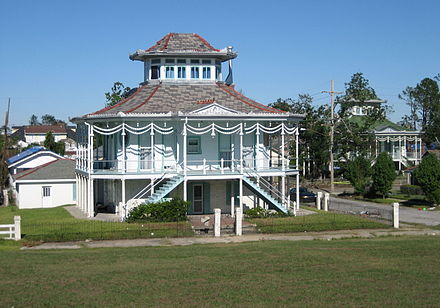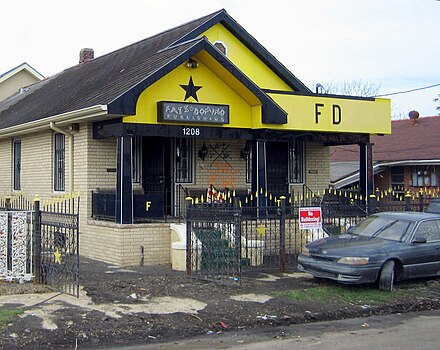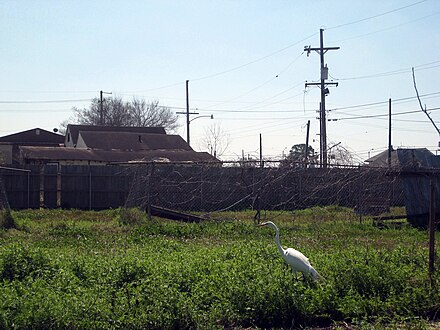New Orleans/Lower 9th Ward - human settlement in New Orleans, Louisiana, United States of America

The Lower 9th Ward is a section of New Orleans, east of the Bywater neighborhood (from which it is separated by the Industrial Canal), north of the Mississippi River, and west St. Bernard Parish, Louisiana.
Understand
This neighborhood of predominantly African-American working-class homeowners became tragically famous when it was smashed by floodwaters with the catastrophic failure of the federal levees during Hurricane Katrina.
Some six years later, a few businesses have reopened, and a fraction of the population is back (some still in "temporary" trailers while they work to rebuild their homes), but large sections of the area are still either seriously damaged or simply empty lots where rows of houses once stood.
Historical background
The area on the river side of St. Claude Avenue developed during the great expansion of New Orleans in the 19th century. The land further away from the river contained scattered houses on plots of farmland; much of the area maintained a more "rural" look into the start of the 20th century.
In the 1910s, the Industrial Canal, a shipping and navigation canal between the Mississippi River and Lake Pontchartrain, was built. It bisected the city's 9th Ward; after the Canal was built people started talking about the two sections as the "Upper 9th Ward" (meaning upriver from the Canal) and "Lower 9th Ward" (meaning downriver from the Canal; contrary to assumptions of people from elsewhere after the Katrina disaster, it has nothing to do with elevation). The Canal led to much more development of the "back" portions of the Ward; many laborers in the port facilities built their houses here.

In the 1940s, musicians of this area created a new musical style of what was then called "rhythm & blues". Fats Domino became the most famous; many of his neighbors also made records in the 1940s and '50s, including the bands that accompanied artists from elsewhere like Little Richard who came to New Orleans to record their hits. Some music historians argue that if the origin of rock & roll can be pinned to any one neighborhood, it would have to be the Lower 9th Ward.
Hurricane Betsy struck Louisiana in 1965. The new MRGO Canal channeled in storm surge from the Gulf of Mexico into the Lower 9th Ward and neighboring Saint Bernard Parish, flooding the majority of it.
The Lower 9th Ward declined in the last quarter of the 20th century, as the port facilities replaced many laborers with automation. Poverty, drug abuse, and related crime grew in the neighborhood. Still, many locals were proud of the Lower 9th Ward for its rich traditions and high rate of Black home ownership.
In August 2005, Hurricane Katrina struck Louisiana. The levee and floodwall system built after Hurricane Betsy to prevent a repeat of the 1965 disaster quickly crumbled—investigations after the fact showed mistakes in the designs (though more than a few locals will say they suspect deliberate sabotage to destroy the predominantly Black neighborhood). Flooding was much worse than in Betsy, and areas that remained high and dry in 1965 found themselves over their heads in water. Collapsing floodwalls unleashed walls of water which bulldozed blocks full of homes into splinters, killing many. Most of the Federal responders were housed in the Lower 9th's Jackson Barracks; when the wall of water came they could do little more than struggle to save themselves.
Similar tales of disaster in 2005 could be told about many other neighborhoods in Greater New Orleans: black, white, and mixed; poor, middle-class, and rich. But the Lower 9th became emblematic of the destruction. Most of the area was so devastated it remained barricaded off when other sections of the city were first reopened. Drinkable running water was restored to the first New Orleans neighborhoods in October of 2005; it did not come to the Lower 9th until October of 2006.
Get in

The two main roadways are Claiborne Avenue and St. Claude Avenue, both of which have bridges over the Industrial Canal connecting them to the Bywater neighborhood and the rest of New Orleans. Heading further southeast are St. Bernard Parish and Chalmette. Car is by far the most practical way to visit, but you can also take Bus 88, St Claude-Delery: you can catch this bus on any corner of St Claude; it runs along St Claude and Rampart through Marigny, French Quarter, and the CBD to the west, the Lower 9th Ward and Arabi in the east.
See
- Fats Domino House, 1208 Caffin Ave. Those wishing to drive by the house of music legend will find it on Caffin St between St. Claude and Claiborne; you can't miss the large letters "F D" on the front.
- House of Dance and Feathers, 1317 Tupelo St, +1 504 278-8242, ronaldwlewis@bellsouth.net. 1317 Tupelo Street. Small museum dedicated to local Mardi Gras Indians and Second Line culture. Curator Ronald W. Lewis has interesting stories. Open by appointment only; contact in advance. Dan Baum's critically acclaimed book, "NIne Lives, Death and Life in New Orleans", which spans the 40 year history between Hurricane Betsy and Katrina, appropriately begins and ends with Ronald Lewis. If you are coming to New Orleans to just drink on Bourbon Street, there is no need to stop here. If you are coming to find a piece of the puzzle that makes The Big E what it is, Ronald's museum and history are worth an hour or two of your time. Have him sign your "Nine Lives" and consider purchasing his own wonderfully documented history of Mardi Gras and the Mardi Gras Indians with help from Neighborhood Story Project. Good stuff. donations
- Jackson Barracks Military Museum, 6400 St Claude Ave, 29.9517°, -90.01°, +1 504 278-8242. M-Sa 10AM-4PM. Jackson Barracks military base has been here since the 1830s. This is an unorthodox choice for most Lower 9th visitors, but the Louisiana National Guard has an interesting military museum, with artifacts, weapons and memorabilia from every major American war. Free
- Steamboat houses on Egania Street at the Mississippi River. A visitor attraction long before Katrina, these over-the-top ornate Victorian wooden houses in steamboat-baroque style are on the high ground of the least affected portion of the Lower 9th (with only a few feet of floodwaters for a few days, as opposed to over the rooftops then 10 feet of standing water for weeks in most of the Lower 9th). Take a look at the exterior of these houses, then walk up to the top of the levee for a striking view of central New Orleans around a bend of the Mississippi.
Tour
Scenes of devastation. Those who wish to see the worst of the destruction can drive around pretty much anywhere north of Claiborne Avenue, but "ground zero" is along Jourdan Avenue north of Claiborne, the site of the major levee breaches. The levees and floodwalls have been rebuilt, the giant barge which landed in the neighborhood has been dismantled, thousands of truckloads of debris have been hauled away, and the vast majority of the thousands of the smashed houses demolished — but the scope of the destruction is still astonishing.
While at first some returned locals resented the thought of being peered at by tourists, at least as many will say the whole world needs to see what happened here and be aware of these Americans' continuing struggle to reclaim their lives. With time the second view has largely prevailed. If you decide to visit the Lower 9th, do so with respect. If your life is better than that of the people living here, make a donation to the Common Ground Collective "Blue House" neighborhood center at 1800 Deslonde St.
"Official" tours are readily available for booking at your hotel downtown, but you are likely to have a much better and less invasive experience off those awkward big tour buses and in your own car (or a privately arranged car). A hotel would certainly be able to get you a local tour guide to come along for a ride, or you could just stop by the volunteer center or the Chinese take out place and start asking locals questions. Another option is the locally-run Ninth Ward Rebirth Bike Tours.
Do
- Zeitgeist Multi-Disciplinary Arts Center, 6621 St Claude Ave, Arabi, +1 504-352-1150. This is a really cool complex with art films/indie films shown nearly every night. Check the calendar before coming, but mostly just to see what's on—it's a busy, thriving arts complex! On the second Saturday of each month 11AM-4:30PM, Zeitgeist opens the Och Gallery, which always has interesting art exhibits. The store is a great browse too, and is open one hour before nightly events. $7
Eat and drink
Eateries and bars are extremely scarce in the Lower 9th Ward, and you will likely find yourself heading west across the bridge to the Bywater for food, be it fried chicken, BBQ, or a nice restaurant a little further away, or for a drink or two at Vaughans or BJ's. Alternatively, head further down river to Chalmette.
- Cafe' Dauphine, 5229 Dauphine St., NOLA 70117 (Cross St. Claude bridge into Lower 9th Ward. Make a right on Egania St. The restaurant is a few blocks ahead on your left at the corner of Dauphine and Egania Sts.), +1 504 309-6391, cafedauphine@yahoo.com. The only sit-down restaurant in the Lower 9th Ward. Owned by a native of the Lower 9. Serving creole comfort food in a relaxed, casual environment. $ 2018-04-12
Sleep
Accommodations in the Lower 9th are available only for volunteers, but they are quite nice.
- Common Ground Relief, 1800 Deslonde St, +1 504 312-1729. Short-term and long-term volunteers stay at one of two buildings
- Bernell's Lower 9th Ward Market, 2036 Caffin Ave, +1 504 319 5886. Check-in: M-F 8AM, Sa 9AM, check-out: M-F 8PM, Sa 6PM. $ 2019-02-15
Stay safe

Connect
The Lower 9th Ward Branch of New Orleans Public Library is at 1611 Caffin Avenue at the corner of Claiborne Avenue; the building also houses the Martin Luther King School.
Go next
The closest fully functioning neighborhood with places to eat and drink is the Bywater, just west across the St. Claude Avenue Bridge. Saint Bernard Parish is to the east along Saint Claude or Claiborne Avenues.
The Lower 9th has received far more attention than the rest of the city and surrounding areas for being the worst hit, and therefore has had the biggest volunteer effort. In some ways, this has left it looking a bit better than worse off neighbors, which have yet to be visited by Brad Pitt with hammer and plywood in hand. Arabi is just across the city line to the east, and remains largely destroyed, along with much of the rest of Saint Bernard Parish. Just beyond Arabi, Chalmette is functioning, but a drive through many residential sections will show vacant lots and boarded houses sometimes more numerous than those rebuilt and reoccupied. For that matter, huge sections of New Orleans such as Lakeview, Gentilly and Eastern New Orleans continue to struggle. If you truly want to understand what happened in this city, you should make a point to see what happened beyond this one small section.
Lower Ninth Ward
Timezone:MultiplePopulation:1,271Coordinates:29.97, -90.01
